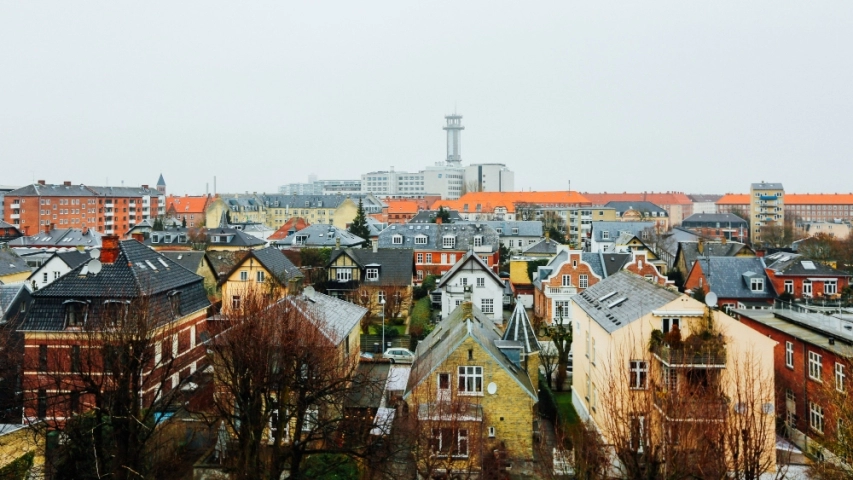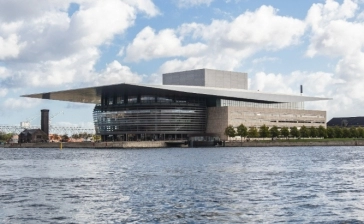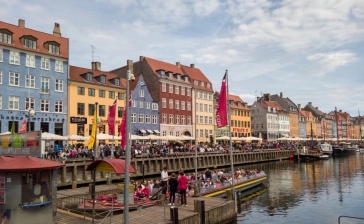Votre Copenhague Guide
Copenhagen: An Accessible City Full of History
Copenhagen, the charming capital of Denmark, is a city with a perfect blend of history, culture, and modernity. With a progressive mindset and well-planned urban design, it is an excellent destination for tourists with reduced mobility. If you are thinking of visiting this vibrant city in a wheelchair or mobility scooter, here we provide all the information you need to enjoy a hassle-free experience.
A Brief History of Copenhagen
Copenhagen has its roots in the 10th century when it was a small Viking fishing settlement. Its name comes from the Old Danish "Køpmannæhafn," meaning "merchants' harbor," as the city quickly grew thanks to trade. In the 15th century, it became the capital of Denmark and has since been the country's cultural, political, and economic center.
During World War II, Denmark was occupied by Nazi Germany, but Copenhagen stood out for its peaceful resistance and the evacuation of thousands of Danish Jews to Sweden to save them from persecution. Today, the city is a symbol of modernity and sustainability, with an enviable quality of life and a strong commitment to accessibility.
Must-Visit Places in Copenhagen
Below are Copenhagen’s most iconic places with information on their accessibility:
Nyhavn
This 17th-century harbor is the city's most iconic image, with vibrantly colored houses and restaurants along the canal. While some cobblestone streets can be uncomfortable for wheelchairs, most sidewalks are accessible, and there are ramps in several spots.
The Little Mermaid
Inspired by Hans Christian Andersen’s fairy tale, this statue is one of Copenhagen’s symbols. It is located on an accessible waterfront promenade and is easy to visit.
Tivoli Gardens
This historic amusement park, opened in 1843, is a must-see. It has accessible pathways and adapted restrooms, though some attractions may not be suitable for people with reduced mobility.
Amalienborg Palace
Home to the Danish royal family, this palace offers spectacular changing of the guard ceremonies. The square is completely accessible, and the museum has elevator access.
Rosenborg Castle
This 17th-century castle houses the Danish crown jewels. While access to the interior may be limited due to its age, the castle gardens are fully accessible and worth a visit.
Strøget
One of Europe’s longest pedestrian streets, filled with shops, cafés, and restaurants. It is completely accessible and an ideal place for a worry-free stroll.
Christiania
This alternative neighborhood, a self-proclaimed “free state,” is famous for its bohemian atmosphere. Some areas may be difficult to navigate with a wheelchair due to uneven paths, but many of its main streets are accessible.
National Museum of Denmark
A must-see tour to learn about the country’s history. It is fully accessible, with elevators and adapted restrooms.
Marble Church
One of Copenhagen’s most beautiful churches, featuring an impressive dome. It has wheelchair access, although some areas may require assistance.
Copenhagen Opera House
A stunning modern building by the water. Designed with accessibility in mind, it has step-free entrances, elevators, and wheelchair-designated seating areas in its performances.
Tips for a Smooth Visit
Book in advance: Although Copenhagen is an accessible city, it is always good to plan ahead if you need special transportation or an adapted hotel room.
Check accessibility maps: The official Copenhagen tourism website provides detailed maps with accessible routes.
Weather: If visiting in winter, keep in mind that snow may make it harder to move around in a wheelchair.
Adapted restrooms: Most tourist attractions and shopping centers have accessible restrooms.
Conclusion
Copenhagen is an ideal destination for tourists with reduced mobility. Its inclusive design, accessible transportation, and friendly locals make exploring the city a pleasant and barrier-free experience. Whether enjoying Nyhavn’s harbor, visiting historic castles, or strolling through pedestrian streets, this Nordic capital offers countless experiences for everyone.
Office du tourisme
Tourist Offices
Copenhagen is a city committed to providing an inclusive and accessible experience for all its visitors. Below are the main tourist offices in the city and at the airport, including the services they offer, their accessibility for people with reduced mobility, and their contact details.
1. Copenhagen Tourist Office (VisitCopenhagen)
Services offered: Provides general tourist information about the city, free maps, recommendations for cultural events, accommodation bookings, and sales of tourist cards such as the Copenhagen Card.
Accessibility: The office is designed to be accessible for people with reduced mobility, featuring ramps and spacious areas to facilitate movement.
Accessible restrooms: Equipped with adapted restrooms for people with disabilities.
Address: Vesterbrogade 4B, 1620 Copenhagen V, Denmark.
Phone: (+45) 7022 2442
Email: info@visitcopenhagen.com
Website: https://www.visitcopenhagen.com
2. Tourist Information Center at Copenhagen Airport
Services offered: Assistance for newly arrived tourists, information on transportation from the airport to the city center, tourist maps and brochures, and last-minute booking assistance.
Accessibility: Located in terminals 2 and 3, the airport is fully adapted for people with reduced mobility, including ramps, elevators, and proper signage.
Accessible restrooms: All airport facilities, including restrooms, are adapted for people with disabilities.
Address: Copenhagen-Kastrup Airport, Terminals 2 and 3, Lufthavnsboulevarden 6, 2770 Kastrup, Denmark.
Phone: (+45) 3231 3231
Email: info@cph.dk
Website: https://www.cph.dk
3. Spanish Tourism Office in Copenhagen
Services offered: Promotion of Spain as a tourist destination in Denmark, travel information and advice for trips to Spain, and collaboration with tourism professionals.
Accessibility: The office is located in an accessible building with an elevator and facilities for people with reduced mobility.
Accessible restrooms: Equipped with adapted restrooms for people with disabilities.
Address: Bredgade 56, 2nd floor, 1260 Copenhagen K, Denmark.
Phone: (+45) 3318 6630
Email: copenhague@tourspain.es
Website: https://www.spain.info/en/tourist-office/copenhagen/
4. VisitDenmark – National Tourism Office
Services offered: Information on tourist destinations across Denmark, promotional materials, and support for tourists and industry professionals.
Accessibility: VisitDenmark offices are committed to accessibility, although it is recommended to contact them in advance for specific details.
Accessible restrooms: Facilities are equipped with adapted restrooms for people with reduced mobility.
Address: Islands Brygge 43, 2300 Copenhagen S, Denmark.
Phone: (+45) 3288 9900
Email: info@visitdenmark.com
Website: https://www.visitdenmark.com
These tourist offices are well-equipped to provide all the necessary information and assistance to ensure your visit to Copenhagen is enjoyable and accessible.
Copenhagen Card
The Copenhagen Card is a tourist pass designed to facilitate and enhance visitors' experiences in Copenhagen. It offers free access to a wide range of attractions and unlimited public transport in the Greater Copenhagen area. Below are its main features:
Types of Copenhagen Card
Copenhagen Card - DISCOVER: Provides free access to over 80 attractions across the capital region, including museums, amusement parks, and historical sites. It also includes unlimited public transport in zones 1-99, covering trains, metro, buses, and boats.
Copenhagen Card - HOP: Offers access to over 40 attractions in central Copenhagen and unlimited travel on Hop-on Hop-off tourist buses.
Included Attractions
With the Copenhagen Card - DISCOVER, you can enjoy free entry to iconic places such as:
Tivoli Gardens: One of the world's oldest amusement parks.
Rosenborg Castle: Home to the Danish crown jewels.
National Museum of Denmark: Showcasing Denmark’s rich history.
The Round Tower (Rundetårn): Offering panoramic city views.
Copenhagen Zoo: Home to a diverse range of animal species.
For a complete list of included attractions, visit the official Copenhagen Card website.
Public Transport
The card includes unlimited travel on trains, metro, buses, and boats within zones 1-99, covering the entire Copenhagen metropolitan area, including transport to and from the airport.
Duration and Prices
The Copenhagen Card - DISCOVER is available in different durations to suit your stay:
24 hours: Adults - €57; Children (3-11 years) - €28
48 hours: Adults - €83; Children - €42
72 hours: Adults - €101; Children - €51
96 hours: Adults - €118; Children - €59
120 hours: Adults - €134; Children - €67
Note: Prices are approximate and may vary; it is recommended to check the latest prices on the official website.
Accessibility
Copenhagen is known for its commitment to accessibility:
Public Transport: The metro, buses, and trains are equipped for easy access for people with reduced mobility, with elevators, ramps, and designated spaces.
Tourist Attractions: Many of the attractions included in the Copenhagen Card are accessible to visitors with disabilities. However, it is advisable to check the specific accessibility of each site beforehand.
Companions: The Copenhagen Card allows a person with a disability to bring a companion for free to included attractions, provided documentation is presented to prove the need for assistance.
How to Get the Copenhagen Card
The card can be purchased online via the official Copenhagen Card app, available for iOS and Android. Once purchased, you will receive a code that can be redeemed in the app to activate your digital card. The activation occurs upon its first use and is valid for the selected period.
Conclusion
The Copenhagen Card is a valuable tool for visitors looking to explore the city in a cost-effective and efficient way, especially for those seeking an accessible and hassle-free experience.
Transport
Airport
Copenhagen-Kastrup Airport (CPH) is recognized for its commitment to accessibility, ensuring that its facilities are comfortable and functional for all passengers, including those with reduced mobility. Below are the available services and facilities:
Entrances and Exits: All terminals have ramps and automatic doors, making access easy for wheelchair users.
Elevators and Escalators: The airport is equipped with spacious elevators and escalators in all key areas, allowing for easy movement between different levels.
Assistance Points
Requesting Assistance: Passengers requiring help can request assistance at designated points located at the main entrances and check-in areas. It is recommended to inform the airport at least 48 hours before the flight to ensure optimal service.
Trained Staff: The airport staff is specially trained to assist people with various disabilities, ensuring respectful and efficient service.
Waiting Areas and Rest Spaces
Waiting Lounges: Equipped with adapted seating and reserved spaces for wheelchairs, ensuring comfort while waiting for boarding.
Quiet Zones: Designated areas provide a relaxed environment away from the main hustle and bustle.
Hygiene Facilities
Accessible Restrooms: Available in all terminals, designed to facilitate use by people with reduced mobility. These restrooms include support bars and enough space to maneuver a wheelchair.
Internal and External Transport
Inter-Terminal Transport: A free internal shuttle service connects the different terminals and is adapted to accommodate wheelchairs.
Public Transport: The airport is connected to downtown Copenhagen via trains, metro, and buses, all of which are accessible to people with reduced mobility. The available options are detailed below.
Parking
Reserved Parking Spaces: The parking areas include designated spots for people with disabilities, located near the main entrances to minimize walking distances.
Information and Contact
Information Desks: Located in all terminals, providing additional assistance and answering accessibility-related questions.
Contact: To arrange assistance services or resolve specific concerns, it is advisable to contact the airport in advance.
In summary, Copenhagen-Kastrup Airport is committed to providing a safe and comfortable experience for all passengers, implementing various facilities and services to ensure accessibility and well-being for people with reduced mobility.
How to Get from the Airport to the City Center:
For people with reduced mobility, Copenhagen Airport offers several accessible transport options to reach the city center. Below are the available alternatives:
Metro
M2 Line: Connects Terminal 3 of the airport directly to the city center.
Accessibility: All stations are equipped with elevators and ramps, making it easy for wheelchair users.
Frequency: Every 4-6 minutes during the day and every 15-20 minutes at night.
Travel time: Approximately 15 minutes to Nørreport Station.
Price: 36 DKK (around 5 euros).
Ticket purchase: Available at ticket machines in the station or via the DOT Mobilbilletter app.
Train
DSB Trains: Depart from the station located in Terminal 3.
Accessibility: Stations and trains are adapted for people with reduced mobility, featuring elevators and designated wheelchair spaces.
Frequency: Every 10 minutes during the day.
Travel time: Around 13 minutes to Copenhagen Central Station (København H).
Price: 36 DKK.
Ticket purchase: Available at ticket machines in the station or through the DOT Mobilbilletter app.
Bus
Line 5C: Departs from Terminal 3 and connects the airport with the city center.
Accessibility: Buses are equipped with ramps and reserved wheelchair spaces.
Frequency: Every 10-15 minutes during the day and every 30 minutes at night.
Travel time: Approximately 35-40 minutes to Copenhagen Central Station.
Price: 36 DKK.
Ticket purchase: Available at automatic machines, 7-Eleven kiosks, or directly from the driver (cash only).
Adapted Taxis
For a more personalized transfer, several taxi companies offer wheelchair-accessible vehicles:
Amager-Øbro Taxi
Phone: (+45) 27 27 27 27
Email: info@taxi.dk
Services: Vehicles equipped for wheelchairs and personalized assistance.
DanTaxi
Phone: (+45) 48 48 48 48
Email: info@dantaxi.dk
Services: Fleet of adapted taxis and trained drivers to assist passengers.
It is recommended to book in advance to ensure availability.
Additional Considerations
Copenhagen Card: This tourist card offers unlimited access to public transport and free entry to various attractions. It is valid on metro, trains, and buses, including the transfer from the airport to the city center. It can be purchased online or at authorized sales points in the airport.
In summary, Copenhagen Airport provides multiple accessible transport options for people with reduced mobility, ensuring a comfortable and efficient transfer to the city center.
Port of Copenhagen
The Port of Copenhagen is a key hub for cruises and ferries and is committed to providing accessible facilities for all passengers, including those with reduced mobility. Below are the available services and facilities:
Cruise Terminals
The port has several main terminals:
Langelinie Pier: Located near the city center, this terminal is frequently used by cruise ships.
Nordre Toldbod: Another centrally located terminal providing easy access to Copenhagen’s main attractions.
Ocean Quay (Oceankaj): The newest and largest terminal, located in the Nordhavn area.
Accessibility at the Terminals
Entrances and Exits: All terminals are equipped with ramps and level access to facilitate movement for wheelchairs and mobility scooters.
Accessible Restrooms: Each terminal has adapted restrooms designed to meet the needs of passengers with reduced mobility.
Personalized Assistance: While facilities are accessible, it is recommended to inform the cruise company in advance if additional assistance is needed during boarding or disembarking.
How to Get from the Port to the City Center
For passengers with reduced mobility arriving at the Port of Copenhagen, there are several accessible transport options to reach the city center. Below are the available alternatives:
Bus
Line 26: Connects the cruise terminals with the city center.
Accessibility: Buses are equipped with automatic ramps and reserved wheelchair spaces.
Frequency: Every 20 minutes during the day.
Travel Time: Approximately 30 minutes to the city center.
Price: 36 DKK (around 5 euros).
Ticket Purchase: Available at ticket machines at stops or directly from the driver (exact change recommended).
Adapted Taxi
For a more personalized transfer, wheelchair-accessible taxis can be reserved. Below are two companies offering this service:
Taxa 4x35
Phone: (+45) 35 35 35 35
Email: callcenter@taxa.dk
Services: Adapted vehicles for wheelchairs and personalized assistance.
Dantaxi
Phone: (+45) 70 25 77 01
Email: dantaxi@dantaxi.dk
Services: Adapted taxis and trained drivers to assist passengers.
Booking in advance is recommended to ensure the availability of adapted vehicles.
Getting Around Copenhagen
Copenhagen is known for its commitment to accessibility, offering a wide range of transportation options adapted for people with reduced mobility. Below are the main available transport modes in the city:
Metro
The Copenhagen Metro is modern and fully accessible.
Accessibility: All stations have elevators and ramps, making access easy for wheelchair users.
Lines and Schedule:
M1 and M2 lines operate 24 hours a day.
Frequency: Every 2-4 minutes during peak hours and up to 20 minutes at night.
Price: A single ticket for 2 zones costs approximately 24 DKK (around 3.20 euros).
Buses
Copenhagen’s bus network is designed with accessibility in mind.
Accessibility:
All buses have manual ramps at the middle doors and designated wheelchair spaces.
Drivers are not allowed to leave their seats, so they cannot provide personal assistance when boarding or disembarking.
Lines and Schedule:
Buses run every 5-10 minutes during the day and every 20-30 minutes at night.
Price: A single ticket for 2 zones costs 24 DKK.
Trains (S-tog)
The S-train system (S-tog) connects the city center with suburban areas.
Accessibility:
Most stations have elevators or level access.
It is recommended to contact DSB in advance at (+45) 70 13 14 15 to confirm the accessibility of specific stations.
Lines and Schedule:
Operating hours: 5:00 AM to 1:00 AM.
Frequency: Every 10 minutes during the day.
Price: A single ticket for 2 zones costs 24 DKK.
Adapted Taxis
For personalized transfers, several companies provide wheelchair-accessible taxis. Below are two options:
Amager-Øbro Taxi 4x27
Phone: (+45) 27 27 27 27
Email: info@taxi4x27.dk
Services: 24/7 availability, wheelchair-accessible vehicles, and trained drivers to assist passengers.
Taxa 4x35
Phone: (+45) 35 35 35 35
Email: info@taxa.dk
Services: Fleet of adapted vehicles and advance booking option to guarantee availability.
Conclusion
Copenhagen’s port, metro, buses, trains, and taxis are designed to accommodate passengers with reduced mobility, ensuring accessible and comfortable transport throughout the city.
Quartiers / zones
Nyhavn, Copenhagen’s most iconic and vibrant neighborhood, is the perfect starting point for an unforgettable visit to the city. From the moment you arrive, the brightly colored historic buildings reflecting on the canal create a warm and lively atmosphere.
We begin our tour in Nyhavn’s most accessible area, where the wide and smooth sidewalks ensure a comfortable journey for wheelchair users. The first stop is the canal, where you can enjoy the view of restored old boats peacefully floating. If the weather is nice, this is an ideal spot for memorable photos or simply relaxing while watching the harbor activity.
Continuing along the waterfront, we head to the opposite end of Nyhavn, where we find the historic house of Hans Christian Andersen. This is a must-visit for literature lovers, as it was here that Denmark’s famous writer lived and wrote some of his best-known stories. While the interior is not fully accessible, the exterior retains its charm, and plaques provide information about Andersen’s life and legacy.
From here, we move toward Kongens Nytorv, located just a few minutes away. This spacious square is fully accessible, featuring benches and rest areas where you can relax while enjoying the city's lively atmosphere. The square is surrounded by historic buildings, including the Royal Danish Theatre, whose impressive Baroque façade is worth admiring. If you have time, you can enter and inquire about accessible tours, as they offer adapted guided visits.
From Kongens Nytorv, we take Strøget, Copenhagen’s most famous shopping street. This pedestrian street is fully accessible and provides a great shopping experience, from international brands to local boutiques and cozy cafés. Halfway down Strøget, we take a short break at Stork Fountain, one of the city’s most famous meeting points. Here, you can pause and observe Copenhagen’s daily life, while street musicians create a lively atmosphere.
We continue toward the Round Tower (Rundetårn), one of the city's most unique and accessible attractions. Built in the 17th century as an astronomical observatory, its interior features a spiral ramp instead of stairs, making it ideal for wheelchair users. From the top, the panoramic views of the city are breathtaking, offering a unique perspective of Copenhagen’s rooftops and streets.
After the visit, we head to Rosenborg Castle, a Renaissance palace surrounded by lush gardens. While the castle’s interior presents some architectural barriers, the King’s Gardens, located just in front, are completely accessible and provide a beautiful setting for a leisurely stroll or a relaxing break surrounded by nature.
After enjoying the outdoors, we make our way back to Nyhavn to end our tour with a meal at one of its accessible restaurants. Many establishments have spacious terraces, allowing you to enjoy Danish cuisine while watching the canal and passersby. From smørrebrød (traditional Danish open sandwiches) to fresh fish and seafood, there are options for all tastes.
For those preferring a more relaxed setting, cafés offer the chance to enjoy a coffee and a Danish pastry before concluding the visit. This tour covers the most iconic spots in Copenhagen’s most famous neighborhood, ensuring a comfortable and accessible experience for all.
Restaurants adaptés / accessibles
Copenhagen is renowned for its vibrant culinary scene and commitment to accessibility. Below are three restaurants in the city that offer adapted facilities for people with reduced mobility, along with a brief description, signature dish, and contact details.
1. Noma
Noma is a three-Michelin-starred restaurant, famous for its innovative approach to Nordic cuisine. It offers a seasonal tasting menu, emphasizing local and foraged ingredients. The restaurant is fully accessible for people with reduced mobility, including step-free entry and adapted restrooms.
Address: Refshalevej 96, 1432 Copenhagen, Denmark
Phone: (+45) 32 96 32 97
Email: info@noma.dk
Website: https://noma.dk
2. Almanak
Located on Copenhagen’s waterfront, Almanak serves classic Danish cuisine with a modern twist, using fresh, local ingredients. The restaurant is accessible for wheelchair users, featuring step-free entry and adapted restrooms.
Address: Havnegade 44, 1058 Copenhagen, Denmark
Phone: (+45) 72 14 88 08
Email: info@thestandardcph.dk
Website: https://thestandardcph.dk/en/restaurant/almanak/
3. Aamanns Deli & Take Away
Specializing in smørrebrød, the traditional Danish open-faced sandwich, Aamanns offers a modern take on this classic, using organic and high-quality ingredients. The restaurant is wheelchair accessible, with step-free entry and adapted restrooms.
Address: Øster Farimagsgade 10, 2100 Copenhagen, Denmark
Phone: (+45) 35 55 33 44
Email: info@aamanns.dk
Website: http://www.aamanns.dk
These restaurants not only provide exceptional dining experiences but also ensure an inclusive and accessible environment for all guests.





